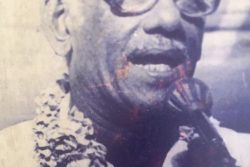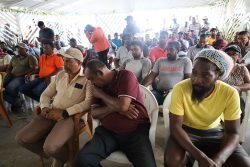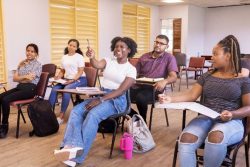Egbert Martin, who published under the pen name ‘Leo,’ (1) was the most accomplished and prolific of Guyanese writers in the nineteenth-century, highly praised by his contemporaries. The great West Indian/American collector and bibliophile, Arthur Schomburg, described Martin as “one of the greatest Negro poets in history.” (2).
Martin’s work also caught the critical attention of Guyanese journalists during the nineteenth century. The Daily Chronicle declared him to be ‘the ablest of the poetical writers of whom British Guiana can boast’ and the Berbice Gazette spoke of him as ‘one whose works plainly bespeak talent and ability of the highest order.’ (3) Lord Tennyson was said to have admired his work. (4)
Today Martin is almost totally forgotten, his work routinely ignored in anthologies of Caribbean writing. Only two copies of his first book of poetry, Poetical Works (1883), are traceable in libraries worldwide; only one copy of his second collection, Leo’s Local Lyrics (1886), has survived; his collection of short stories, Scriptology (1885), is untraceable.
Very little is remembered and recorded of Martin’s life. He was born around 1861, presumably in the capital, Georgetown. His father, Richard, was a journeyman tailor. No information survives about his mother or any siblings. A.J. Seymour, who described him as ‘a fair mulatto,’ states that ‘from early youth he was confined to an invalid’s bed, as a result of illness.’ (5) The Colonist, a Guyanese journal, first published his poetry when he was nineteen years of age, and thereafter he was a frequent contributor to The Argosy and Echo. His patrons were James Thompson, editor of The Argosy, and George Anderson Forshaw, Mayor of George-town. It was said that Thompson would visit Martin at his home in East Street, Georgetown, to collect his poetry for printing in The Argosy.
Martin gained a degree of international prominence in 1887 when he won an Empire-wide competition for adding two verses to the British national anthem, an event sponsored by the London Standard to mark Queen Victoria’s Golden Jubilee. He died on June 23, 1890. His death certificate states his age as twenty-nine and the cause of death as ‘phthisis’ (tuberculosis, or ‘consumption,’ also known as the ‘White Plague’ because its sufferers appeared markedly pale. It may well be that Martin was a ‘fair mullatto’ because of his medical condition). His death was registered by his cousin Edwin Heyliger, so it would appear that Martin was partly of German ancestry. (6)
Contemporaries and
Cultural Milieu
British Guiana, though a lonely colony in South America, separated geographically from the rest of Britain’s Caribbean colonial possessions, was not a backwater in cultural terms. In 1851, the Athenaeum Society (possibly modeled after London’s Athenaeum Club, founded in 1823 for men of scientific, literary and artistic talent) was established in Georgetown and hosted dramatic performances. The Assembly Rooms, owned by the Royal Agricultural and Commercial Society, was also a leading theatre venue, containing an auditorium which could seat up to one thousand people. In the 1860s, establishments like the Adelphie Theatre and the Philharmonic Hall staged ‘numerous plays, musicals and operas . . . by local clubs and foreign theatrical companies.’ There were regular performances by members of societies like the Amateur Dramatic Club and the Histrionic Club, and later, the Demerara Dramatic Club and the Georgetown Dramatic Club.
On April 17, 1890, two months before Martin’s death, the Georgetown Botanical Gardens was the venue of a programme of music, played by the Militia Band, including works by the French composers Daniel Auber and Emile Waldteupel. (7) Literary texts were available in the readings rooms of the Royal Agricultural and Commercial Society and in educational establishments like Queen’s College: N.E. Cameron lists public readings of works by Shakespeare, Horace, Byron, Homer, Racine, and Ovid at Queen’s College in the 1870s. (8) Learned people like Martin’s patrons would have owned personal libraries and made their books available to each other.
The cultural milieu of nineteenth-century Georgetown produced local musicians, actors and directors. Among the most notable poets were Simon Christian Oliver and Thomas Don. Oliver was a schoolmaster who was writing and publishing in the 1830s. He was relatively wealthy, his son being a businessman and his daughter receiving an education in England. Don, by contrast, was a former slave, and like African slaves in the New World, he became literate by exposure to the Bible. His book, Pious Effusions, published locally in 1873, consisted of hymn-like stanzas on religious subjects. These poets belonged, according to P.H. Daly, to “a generation of Spiritual Men . . . however much they were engrossed with the affairs of their temporal order, they saw only the spiritual side of the synthesis.” (9)
The following generations (late nineteenth-century/early twentieth-century) represented by poets T.R.F. Elliott and J.E. Clare McFarlane nurtured racial pride or protested about social injustices.
Martin’s Poetry
Apart from the odd poem like ‘The Negro Village,’ which speaks of the African-Guyanese history of ‘toil and struggle’ and asserts their humanity, their capacity to love, to form families and to be governed by ‘nobler passions,’ Martin’s poetry is more preoccupied with spiritual matters. Given his frail physical condition it is unsurprising that he writes extensively on change, disintegration and death. His mediations on the passage of time can be startling postmodern in their sense of dimensions beyond the linear.
‘Tis looking back that gives the future colour,
Because, in life, we find
The past analogizes all the future
Upon the plastic mind;
Foreshadowing what ”will be,” and what ”had been,”
A mingled repetition
Of words and deeds, events, and many a scene,
And fantasy and vision.
(‘Looking Back’)
And yet, whilst recognizing the ways time ravishes the human body, moulding and sculpting past and future together into an aesthetic of suffering, Martin is constantly seeking a perfection of form that transcends the material, that is not, nor cannot be shaped by time. Sudden moments of natural beauty (‘Thanksgiving’; ‘Along Yon Stretch’) yield intimations of divine truth, and of a space beyond time ‘Where all that’s rich is permanent/ Where visions bright endure/ Unchanging, blessed and beautiful/ And true for evermore.’ The echo here of Keats is diminished elsewhere, for Martin constantly struggles to maintain his faith in the truth of beauty. In ‘Disappointment,’ Wordsworthian sentiments about intimations of immortality are dismissed in favour of a Darwinian vision of nature:
With hasty hand I tore the flower
And flung it from its place;
And since that agonizing hour,
For me it lost all grace.
Anon I thought, in pensive mood,
How ‘midst a gem so fair,
In hidden ambuscade there should
Repose a viper’s lair.
(‘Disappointment’)
Martin effects a christian synthesis between the truth of decay and the truth of beauty: it is through suffering that man is made perfect (‘Made Perfect Through Suffering’). For Martin, the poet is almost a divine figure – ‘he weaves a song divine’ (‘The Poet’). The poet is God’s alchemist:
He takes into his hands the clay
All shapeless, black and dull,
Tears every harsher vein away,
And leaves it beautiful;
Leaves in the place of what had been
A mass of baseless mould,
A figure, shape, or fantasy,
Transformed to purest gold.
(‘The Poet’)
Men like Sir Walter Raliegh came to the Guyanas in search of gold, but died in penury, for the true gold is the poet’s imagination. The poet creates, through his imagination, but he also perceives the perfection of what already exists:
A gold
en glow of rippling clouds
Serenely saileth by,
As if the hand of God has writ
A poem in the sky.
(‘Along Yon Stretch’)
Perfection of form is what Martin’s poetry strives to achieve. His body is that of man, subject to decay, but his poetry is testament to faith in a perfection that survives such decay. Martin is above all a poet. Hence his mastery of the cadences of Victorian verse as well as the network of allusions to English poetry from the Medieval period onwards.
Hence, too, his utmost delight in the spaciousness and poetical quality of English words: his poetry is sprinkled with adjectives like ‘umbrageous,’ ‘eocene,’ ‘auriferous’ and the like.
Martin may have been a Victorian writer in terms of using the language and formal models of his age, but in poems like ‘The Spirit Stone’ and ‘The Sorrel Tree’ his work is cross cultural in his depiction of the landscape – actual and spiritual – of Guyana.
In the months before his death, the Guyanese newspapers said on the impropriety of language in the streets of Georgetown: “it is exceedingly painful to hear and witness the extraordinary amount of indecent language and unbecoming behaviour exhibited by drunken women every hour of the day . . . in the very face of the police, the most offensive language is used . . .” (Daily Chronicle, Tuesday April 18, 1890). It was not until the next century that a new poetry arose, based on the thew and sinew of the Creole language of the streets.(10) The ‘vulgarity’ of the new writing would appear to be utterly different from Martin’s, but the poetic project was the same: the quest for El Dorado, sifting through the rubble of experience for the gold of the imagination.
David Dabydeen’s edition of Martin’s poems, Selected Poems Of Egbert Martin, will be published by the Derek Walcott Press in March 2007.
Acknowledgments
I’m grateful to the British Academy for assisting with research expenses, and Ian MacDonald for introducing me to the work of Egbert Martin and encouraging me to reprint his poetry.
1 The self-naming is ironic, in light of the Classical names – Caesar, Horace, Juno, etc. – given mockingly to slaves; in light, too, of Martin’s frailty.
2 See Eleanor Sinnette, Arthur Alfonso Schomburg (1989).
3 Quotations from newspapers are to be found on the end-page of Leo’s Local Lyrics (1886).
4 According to The Argosy and The Guiana Herald, both quoted in Leo’s Local Lyrics, ibid.
5 A.J. Seymour, in Kyk-Over-Al, Vol. 1, No. 3, December 1946.
6 I am grateful to Evan Persaud for helping me to locate Martin’s death certificate in the Georgetown Registry of Births, Marriages and Deaths (Superintendent Registrar’s District K, Division No. 28, Page 119, Entry 1188). Between 1834 and 1838, 1,300 German immigrants landed in Jamaica to work on the sugar plantations. Others migrated elsewhere in the Caribbean. See M.S. Wokeck, Trade in Strangers. The Beginnings of Mass Migration to North America (1999).
7 Daily Chronicle, Thursday 17 April, 1890.
8 N.E. Cameron, A History of the Queen’s College (1951), pp. 25-26.
9 P.H. Daly, Currents in Caribbean Life (1955), p. 37. See too N.E. Cameron (ed.), Guianese Poetry (1931) and A.J. Seymour, The Making of Guianese Literature (1982).
10 See D. Dabydeen’s ‘Introduction,’ in Slave Song (1984).









